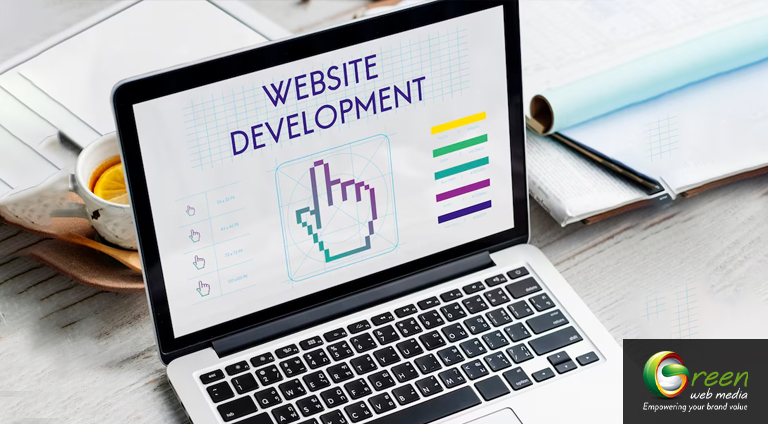Web Development Overview: Guide for Beginners

It’s evident that creating an online presence has become an essential requirement for any company striving for achievement. This manual will cover all the necessary information about web development. Now, let’s see what is changing in web development and how businesses can benefit from these changes to remain exciting and current.
What Is Web Development?
Web development is the practice of creating websites as well as applications that work on the Internet. It includes everything – from the most straightforward static page containing some text to a multi-faceted interactive website comprising a lot of social engagement. It entails programming as well as constructing unique components of the website, structure, and design that users see and use through the web browser. Web design focuses on the look and ease of use of a website, while web development is about putting that design into action using HTML, CSS, JavaScript, and various frameworks. All these elements are integrated to provide users with a convenient digital platform.
Web Development vs. Web Design
Web development and web designing are complementary yet entirely different. Web development includes building websites as technical structures, which include coding, databases, and embedded functions. However, we can say that web design includes the general look and feel of the interface, including the layout, colors, and various images. Such clarification is beneficial for businesses, for it helps them use their resources more productively without compromising either the visual or practical components of their websites.
Why Businesses Should Invest in Web Development
These are some of the reasons why web development is a worthwhile investment. One more reason is improved reach, engagement, and sales, among others. Having an appropriately developed site, businesses enable their customers to enjoy site usability and features such as fast loading speeds and site responsiveness. Today’s busy shoppers prefer simple, easy-to-use websites and experiences, which companies focused on growing their online presence can profit from.

Emphasis on User-Centric Design
These days, people must build interfaces that people appreciate because competition is more challenging than ever before. User-centric design takes focus on the user’s needs and preferences thus making the websites not only useful but also easy to navigate. These are the main ways user-centered design is expected to develop in the year 2024:
- Personalized Experiences
Personalization, influenced mainly by AI and analytics, enables websites to tailor the content, offers, and navigation to the individual user. This approach improves user engagement as it makes the experience more relevant. For instance, if a shopper goes to an online store, certain items could be recommended based on the pages already explored by that shopper, whereas a news site could serve articles that the typical user would be interested in. Personalization encourages brand loyalty and increases conversions for a brand.
- Micro-Interactions and Animations
To avoid cluttering the user interface, UI designers have found a great solution in micro-interactions and animations. These are pretty simple design features, such as a button changing color when the cursor is over it, an animated icon showing the page is loading, or a smooth change in position when a user scrolls down the page. Such features make the site more usable and interactive, as well as provide visual feedback which also enhances the page’s usage. Micro-interactions guide users on their next steps, simplifying navigation and tasks and enhancing the interface’s ease and memorability.
- Minimalistic and Clean Design
Once again, the importance of simplicity comes into play as we see that minimalism is one of the trends in the world of websites. Balanced layouts, sufficient white areas, and modest colors create a pleasant impression because it is stylish and contemporary. The minimalist design is also suitable for mobile users as it provides fast load times and simplifies navigation on smaller displays.
Major Web Development Technologies
Web development technology is progressing at a very rapid pace, so keeping pace is crucial if one wants to build successful, high-quality websites. Here are some of the significant technologies that are shaping web development:
- JavaScript Frameworks
JavaScript frameworks are key to web development, helping to make websites fast, dynamic, and full of features. The top frameworks, React, Vue, and Angular, are chosen for their popularity and simplicity. React stands out for its ability to build reusable parts, making development more straightforward. Vue has a variety of strengths and is simple, thus being suitable for small and large applications alike. Angular is a very robust framework and is ideal for the development of complex web applications, enabling the creation of a wide range of unique features. Such frameworks allow developers to build more interactive user interfaces and administer intricate interfaces more easily.
- Progressive Web Apps
They provide fast, secure, and entertaining features where it feels like an app but through the internet. PWAs are able to load in low connectivity as well, and they can be placed on the user’s home screen for direct access, much like a native application. For the companies, PWAs avoid the costs of development as there is no requirement to create standalone native apps for iOS and Android. They are comfortable due to their offline capabilities and app-like design.
- Single Page Applications (SPAs)
Single Page Applications (SPAs) are web apps that have just one HTML page that loads new content as the user uses the app. SPAs depend on JavaScript frameworks like React, Angular, and Vue, which are very useful since only the needed content of the page is processed instead of the whole page. Performing loading tasks is more straightforward now because it improves delivery and makes the interaction more like using an app.

The Web Development Process
- Planning and Requirements Gathering
Proper project planning is as necessary as breathing air for every successful project. This stage includes outlining the project’s goals, performing a user analysis, and establishing technical documentation. All those phases of planning enable the developers to be able to deliver a product that meets the expectations of the client and its functional objectives.
- Design and Prototyping
Within this stage, the designers produce wireframes and prototypes that illustrate the site pages’ basic structure and interaction. This makes it possible for teams to evaluate the interface design and implement changes so that the final design conforms to what the end users need when coding is done.
- Development and Testing
This stage covers software development activities, needed integration and cross-browser and cross-device functional and compatibility testing. Development teams often include manual and automated testing as an approach for bug identification and fixing to ensure a site’s smooth operation.
- Deployment and Maintenance
The tested site is now ready to launch and will enter the maintenance phase. This includes regular updates, security checks, and performance monitoring to keep the website relevant and secure over time.
Trends in Web Development in 2024
- Mobile-first approach and Responsive Design
It is essential to apply a mobile-first design because over half of web traffic originates from mobile devices. Always responsive design allows to fully recreate the website’s functioning, improving users’ experience and increasing its SEO rates.
- Core Web Vitals Optimization
Core Web Vitals are performance metrics that affect SEO and user experience, including loading speed, interactivity, and visual stability. Completing the metric in these sections is necessary, gradually improving the search and user retention processes.

Security protocols in web applications
Security is at the top of any website’s hierarchy. Websites take threats seriously, using HTTPS, encryption, and regular software updates to protect sensitive data and build user trust.
- Performance Monitoring
After launching, paying close attention to metrics using Google Analytics and Google Search Console is advisable. In order to obtain a positive outcome, the page’s loading speed, bounce rate, engagement, and similar factors should be actively tracked.
- SEO Optimization
SEO is important for making your site more visible. After launching, add keywords, meta descriptions, alt tags, and structured data to improve your site’s chances of ranking higher. Frequent changes also help to ensure longevity in the online relevance of the sites.
- Regular Updates and Maintenance
Routine maintenance is essential to ensure optimal use and performance of the site. Updating the site regularly helps to increase security, patch bugs, and enhance the site’s overall usability.
Create a compelling and future-proof website with Green Web Media
Web development in the year 2024 is expected to be very interesting, with the insertion of AI technologies and Web3 technology enabling further engagement with the user. Maintaining awareness of the evolution of web technologies enables businesses to create effective web pages that attract customers. Businesses that quickly adapt these advancements will be the most successful in a growing digital world.
With Green Web Media, your business gets to enjoy the cost and time advantages of new technologies to the fullest by effectively engaging users, driving traffic to the site, and performing other beneficial tasks in the web space. Our team stays updated with the latest advancements in web development, ensuring your website is optimized for both performance and user satisfaction. Allow us to assist you in utilizing the latest technologies to build a smooth online presence that achieves enduring outcomes.





